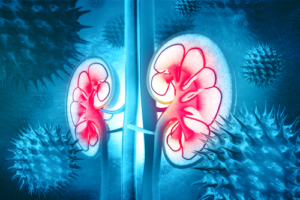Interventional Care


We notice that you are visiting us from . This site only services US-based visitors. Would you like to visit the site that is appropriate for your location?

Healthy kidney function is an integral part of maintaining the balance of the body to sustain life. The purpose of your two kidneys are to prevent a buildup of wastes and extra fluid in the body, which is excreted through daily urinary output. They maintain levels of electrolytes, such as sodium, potassium, and phosphate, and help keep bones strong. They also facilitate production of red blood cells, as well as hormones to help regulate blood pressure.1
Waste is a good thing:
Kidneys keep the composition of the blood stable, and help maintain normal blood pH to maintain adequate body function. Each day, the kidneys filter about 120 to 150 quarts of blood to produce about 1 to 2 quarts of urine, composed of wastes and extra fluid.2 The inability of the kidneys to filter waste products may result in kidney failure and subsequent mortality. Kidney function is adversely affected by trauma or other disease states. Kidney failure is the last stage of chronic kidney disease, but the most severe, known as end-stage renal disease (ESRD). The most common cause of ESRD is Diabetes, while high blood pressure is the second most common cause.3 Both diabetes and hypertension affect and damage the blood vessels and circulation. This prevents the kidneys from receiving adequate oxygenated blood, which helps maintain kidney health and function
Role of Dialysis:
When kidney failure takes place, dialysis is used to artificially perform the functions of the kidney. Hemodialysis is a process that filters the blood system to remove waste and fluids. This procedure usually takes several hours for each session and is performed several times per week to minimize toxic waste build up in the body.
Dialysis is performed in a hospital setting or outpatient dialysis center. Because the procedure is performed so frequently, secure access to the blood system is done through a minor surgical procedure. A fistula is one type of access made by joining an artery to a vein under the skin to make a larger and stronger blood vessel. However, if your blood vessels are not adequate for a fistula, a graft may be used which is a soft plastic tube placed under the skin to join an artery and a vein to make the blood vessel stronger. Occasionally, an access is made by means of a narrow plastic tube, called a catheter, which is inserted into a large vein in your neck.4
Infection Prevention in Dialysis:
Dialysis can take over the patient’s life. The hope is that when they are out of the dialysis chair, they go about their normal daily routines. The reality is that these patients are immunocompromised, so it’s important to ensure infection does not become an additional effect of the process.
You can help that prevention: The CDC offers core infection prevention interventions when caring for the dialysis patient. These include, skin antisepsis, catheter hub disinfection, hand hygiene and environmental cleaning and disinfection.
Skin antisepsis and catheter hub disinfection5:
Hand Hygiene: Hands are the most common method of transmission of infection agentsand often, the most overlooked. Staff and patients should be included in the hand hygiene routines in dialysis.
Environmental Cleaning and Disinfection: Select proper disinfectant(s) and determine correct dilution(s) for routine use. Use only Environmental Protection Agency (EPA) registered hospital disinfectants.Routine disinfection of environmental surfaces can be accomplished using a low-level disinfectant (any EPA-registered hospital disinfectant); However, intermediate-level disinfectants must be available in the dialysis facility for disinfection of surfaces that are visibly soiled with blood or body fluids.
So What?
Patients with ESRD are immunocompromised with additional comorbidities and are subsequently at high-risk for more infections. It’s important to carefully assess each patient to provide the maximum care and mitigate these potential issues with a full, comprehensive checklist that addresses all areas of infection prevention. Monitor not only the skin integrity of the patients and their individual needs, but also address the environment in which they receive treatments and the caregivers who come in contact with them. The gold standard should be to give patients the highest quality of life they can expect.
Dialysis plays a critical role in the quality of life for patients with ESRD. Infection prevention is a necessity in this population. The combination is a winning formula for sustaining life, don’t you agree?
1,2., U.S. Department of Health and Human Services , National institute of Digestive ad Diabetes and Kidney Diseases, Your Kidneys and How They Work.
3. Kidney Failure (ESRD) Causes, Symptoms, & Treatments – American …www.kidneyfund.org/kidney-disease/kidney-failure/
4. (National kidney foundation) A to Z Health Guide: Dialysis
5. http://www.cdc.gov/dialysis/prevention-tools/core-interventions.html#sites). Core Interventions for Dialysis Bloodstream Infection (BSI) Prevention, http://www.cdc.gov/dialysis
6. CDC Dialysis Collaborative; Audit Tool: Hemodialysis hand hygiene observations
7. Environmental Surface Disinfection in Dialysis Facilities: Notes for Clinical Managers; Environmental Protection Agency. (2012, Oct 22). Selected EPA-registered Disinfectants. Retrieved from http://www.epa.gov/oppad001/chemregindex.htm.
b Centers for Disease Control and Prevention. Guidelines for Environmental Infection Control in Health-Care Facilities. MMWR 2004;52(RR10):1-42.